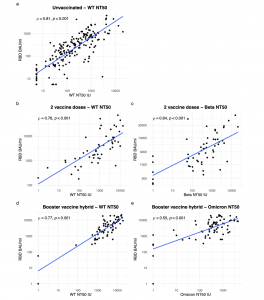In a recent study, researchers have described a critical threshold of immunity to SARS-CoV-2, the virus responsible for COVID-19 (Figure 1). This study focuses on determinoing the relationships between antibodies targeting the Receptor-binding domain (RBD) of COVID-19 and their proficiency in neutralizing the virus. The RBD is a crucial component that facilitates the virus’s entry into cells, making it a primary target for preventing and treating COVID-19.

Figure 1: Correlation between RBD and NT50. Two-tailed Spearman correlation between RBD and NT50. a Unvaccinated convalescent participants and WT-B NT50 (exact p-value < 2.2e-16). b Participants who had received only a primary vaccine series and WT-B.1.177.18 NT50 (exact p-value < 2.2e-16). c Participants who had received only a primary vaccine series and Beta NT50 (exact p-value = 1.381e-07). d Participants who had received one booster vaccine dose and had a history of infection and WT-B.1.177.18 NT50 (exact p-value = 3.99e-15). e Participants who had received one booster vaccine dose and had a history of infection and Omicron NT50 (exact p-value = 1.042e-06). Source data are provided as a source data file.
The research has provided great insight — a RBD titer of 456 BAU/ml emerges as a robust predictor of effective neutralization against both the original SARS-CoV-2 strain and its variants. This threshold exhibits high sensitivity and specificity, providing a reliable measure of immunity. The study’s validity extends across distinct periods of the COVID-19 pandemic: pre-vaccination, post-vaccination, and the current phase characterized by a substantial number of individuals having received vaccinations and been previously infected, leading to hybrid immunity.
These findings have implications for the strategic utilization of vaccines and treatments against SARS-CoV-2. By establishing a clear immunity threshold, this research equips both individuals and physicians with valuable insights, fostering informed decision-making. The application of this knowledge can significantly impact vaccination strategies, therapeutic interventions, and public health initiatives, ushering in a more precise and targeted approach in the ongoing battle against COVID-19.
Journal article: Kenny, G et al, 2023. Distinct receptor binding domain IgG thresholds predict protective host immunity across SARS-CoV-2 variants and time, Nature Communications.
Summary by Stefan Botha










